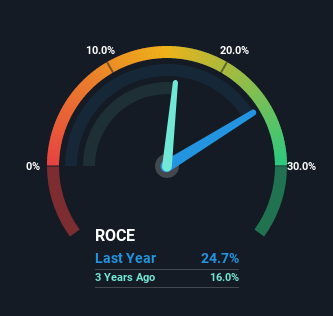Returns On Capital Are A Standout For Southern Petrochemical Industries (NSE:SPIC)

There are a few key trends to look for if we want to identify the next multi-bagger. Firstly, we'll want to see a proven return on capital employed (ROCE) that is increasing, and secondly, an expanding base of capital employed. Ultimately, this demonstrates that it's a business that is reinvesting profits at increasing rates of return. So when we looked at the ROCE trend of Southern Petrochemical Industries (NSE:SPIC) we really liked what we saw.
What Is Return On Capital Employed (ROCE)?
For those that aren't sure what ROCE is, it measures the amount of pre-tax profits a company can generate from the capital employed in its business. The formula for this calculation on Southern Petrochemical Industries is:
Return on Capital Employed = Earnings Before Interest and Tax (EBIT) ÷ (Total Assets - Current Liabilities)
0.25 = ₹2.2b ÷ (₹24b - ₹15b) (Based on the trailing twelve months to September 2022).
So, Southern Petrochemical Industries has an ROCE of 25%. In absolute terms that's a great return and it's even better than the Chemicals industry average of 17%.
Check out our latest analysis for Southern Petrochemical Industries

Historical performance is a great place to start when researching a stock so above you can see the gauge for Southern Petrochemical Industries' ROCE against it's prior returns. If you want to delve into the historical earnings, revenue and cash flow of Southern Petrochemical Industries, check out these free graphs here.
What Does the ROCE Trend For Southern Petrochemical Industries Tell Us?
Southern Petrochemical Industries is displaying some positive trends. The numbers show that in the last five years, the returns generated on capital employed have grown considerably to 25%. The company is effectively making more money per dollar of capital used, and it's worth noting that the amount of capital has increased too, by 110%. The increasing returns on a growing amount of capital is common amongst multi-baggers and that's why we're impressed.
On a separate but related note, it's important to know that Southern Petrochemical Industries has a current liabilities to total assets ratio of 61%, which we'd consider pretty high. This can bring about some risks because the company is basically operating with a rather large reliance on its suppliers or other sorts of short-term creditors. While it's not necessarily a bad thing, it can be beneficial if this ratio is lower.
The Key Takeaway
All in all, it's terrific to see that Southern Petrochemical Industries is reaping the rewards from prior investments and is growing its capital base. Since the stock has returned a solid 84% to shareholders over the last five years, it's fair to say investors are beginning to recognize these changes. In light of that, we think it's worth looking further into this stock because if Southern Petrochemical Industries can keep these trends up, it could have a bright future ahead.
Southern Petrochemical Industries does come with some risks though, we found 2 warning signs in our investment analysis, and 1 of those can't be ignored...
If you want to search for more stocks that have been earning high returns, check out this free list of stocks with solid balance sheets that are also earning high returns on equity.
If you're looking to trade Southern Petrochemical Industries, open an account with the lowest-cost platform trusted by professionals, Interactive Brokers.
With clients in over 200 countries and territories, and access to 160 markets, IBKR lets you trade stocks, options, futures, forex, bonds and funds from a single integrated account.
Enjoy no hidden fees, no account minimums, and FX conversion rates as low as 0.03%, far better than what most brokers offer.
Sponsored ContentNew: Manage All Your Stock Portfolios in One Place
We've created the ultimate portfolio companion for stock investors, and it's free.
• Connect an unlimited number of Portfolios and see your total in one currency
• Be alerted to new Warning Signs or Risks via email or mobile
• Track the Fair Value of your stocks
Have feedback on this article? Concerned about the content? Get in touch with us directly. Alternatively, email editorial-team (at) simplywallst.com.
This article by Simply Wall St is general in nature. We provide commentary based on historical data and analyst forecasts only using an unbiased methodology and our articles are not intended to be financial advice. It does not constitute a recommendation to buy or sell any stock, and does not take account of your objectives, or your financial situation. We aim to bring you long-term focused analysis driven by fundamental data. Note that our analysis may not factor in the latest price-sensitive company announcements or qualitative material. Simply Wall St has no position in any stocks mentioned.
About NSEI:SPIC
Southern Petrochemical Industries
Engages in the manufacture and sale of fertilizers in India and internationally.
Adequate balance sheet with acceptable track record.
Similar Companies
Market Insights
Community Narratives




